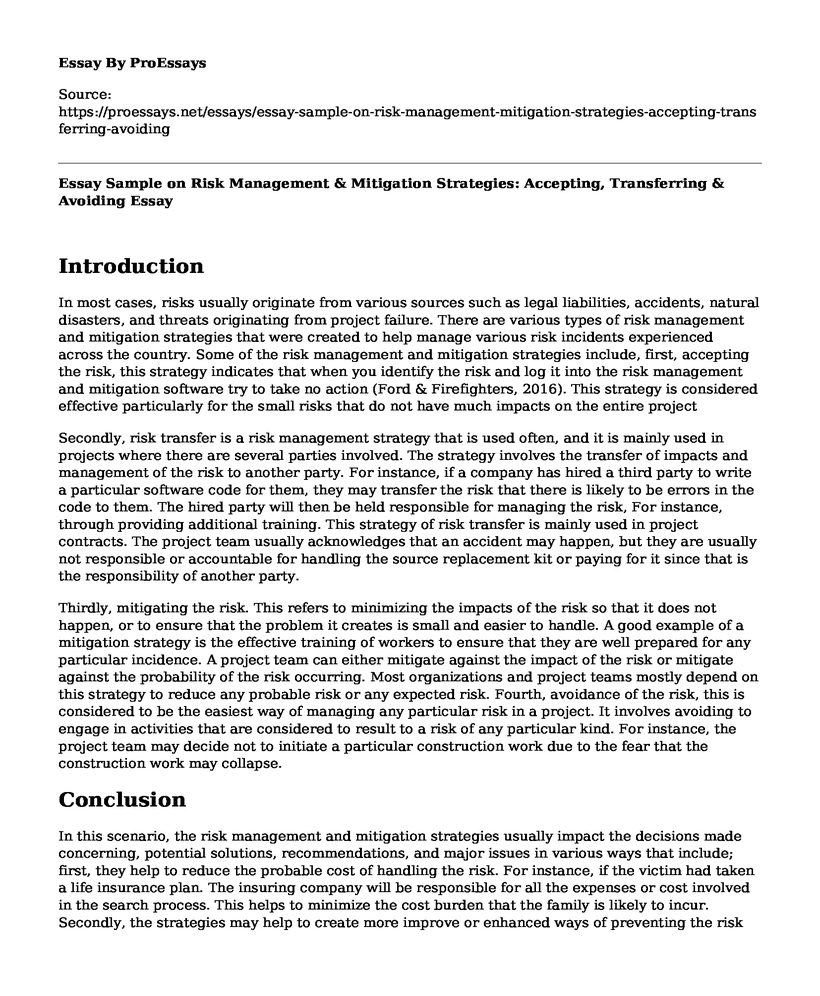Introduction
In most cases, risks usually originate from various sources such as legal liabilities, accidents, natural disasters, and threats originating from project failure. There are various types of risk management and mitigation strategies that were created to help manage various risk incidents experienced across the country. Some of the risk management and mitigation strategies include, first, accepting the risk, this strategy indicates that when you identify the risk and log it into the risk management and mitigation software try to take no action (Ford & Firefighters, 2016). This strategy is considered effective particularly for the small risks that do not have much impacts on the entire project
Secondly, risk transfer is a risk management strategy that is used often, and it is mainly used in projects where there are several parties involved. The strategy involves the transfer of impacts and management of the risk to another party. For instance, if a company has hired a third party to write a particular software code for them, they may transfer the risk that there is likely to be errors in the code to them. The hired party will then be held responsible for managing the risk, For instance, through providing additional training. This strategy of risk transfer is mainly used in project contracts. The project team usually acknowledges that an accident may happen, but they are usually not responsible or accountable for handling the source replacement kit or paying for it since that is the responsibility of another party.
Thirdly, mitigating the risk. This refers to minimizing the impacts of the risk so that it does not happen, or to ensure that the problem it creates is small and easier to handle. A good example of a mitigation strategy is the effective training of workers to ensure that they are well prepared for any particular incidence. A project team can either mitigate against the impact of the risk or mitigate against the probability of the risk occurring. Most organizations and project teams mostly depend on this strategy to reduce any probable risk or any expected risk. Fourth, avoidance of the risk, this is considered to be the easiest way of managing any particular risk in a project. It involves avoiding to engage in activities that are considered to result to a risk of any particular kind. For instance, the project team may decide not to initiate a particular construction work due to the fear that the construction work may collapse.
Conclusion
In this scenario, the risk management and mitigation strategies usually impact the decisions made concerning, potential solutions, recommendations, and major issues in various ways that include; first, they help to reduce the probable cost of handling the risk. For instance, if the victim had taken a life insurance plan. The insuring company will be responsible for all the expenses or cost involved in the search process. This helps to minimize the cost burden that the family is likely to incur. Secondly, the strategies may help to create more improve or enhanced ways of preventing the risk situation. Developing such solutions may help to reduce the magnitude of the risk in the near future.
Reference
Ford, T. M., & Firefighters, N. F. (2016). Fire and Emergency Services Safety & Survival. Pearson. Retrieved from https://www.pearson.com/us/higher-education/series/Fire-and-Emergency-Services-Safety-and-Survival/3480487.html
Cite this page
Essay Sample on Risk Management & Mitigation Strategies: Accepting, Transferring & Avoiding. (2023, Feb 22). Retrieved from https://proessays.net/essays/essay-sample-on-risk-management-mitigation-strategies-accepting-transferring-avoiding
If you are the original author of this essay and no longer wish to have it published on the ProEssays website, please click below to request its removal:
- Essay Sample on Positive Aspects of the Memo about Leadership
- The Management of Pizza Palace Mini Case Review
- The Influence of the Work Environment on Training Transfer Essay
- Essay Sample on The Ecclesial Leadership
- Essay on Amazon.com: 1994-750000 Employees, E-Commerce Success & Global Expansion
- Developing Competencies: Impact of Research and Writing - Essay Sample
- Optimizing Projects: Establishing Necessary Methods & Processes - Essay Sample







